Inclusive Community Design: Design Thinking Workshop on Local Engagement for Diverse Populations

All photos in this article are by Kristina Ahlers-Seibel, photographer, videographer and designer
Design thinking is a problem solving method geared to overcome wicked problems, that have no right or wrong solution and resist traditional scientific and engineering approaches, as “the information needed to understand the problem depends upon one’s idea for solving it” (Rittel & Webber, 1973, 161).
Design thinking aims at transcending the immediate boundaries of the problem to ensure that the right questions are being addressed. The process foresees steps that allow participants to analyze, synthesize, diverge and generate insights from different domains through drawing, prototyping and storytelling (Brown, 2009). During the design thinking process, the facilitator encourages learners to see constraints as inspiration (Brown & Wyatt, 2010). The results are typically not directed toward a technological “quick fix” but toward new integrations of signs, things, actions, and environments (Buchanan, 1992).
The essence of design thinking is to put learners into contexts that make them think and work like an expert designer, and thereby foster civic literacy, empathy, cultural awareness and risk taking (Innovating Pedagogy, 2016).
As awareness of the designed experience increases, so does the desire to apply the process of design thinking to a wider range of scenarios to analyze and resolve any business or productivity challenge in a new, insightful, invigorating manner (Hodgkinson, 2013). Achieving greater inclusion through planning and development is one such challenge.
In February 2018 I had the pleasure to moderate a design thinking workshop at Muenster University of Applied Sciences (Germany). The workshop on inclusive community development brought together researchers from different disciplines, city planners, architects and students. The workshop engaged participants with participatory development techniques and design thinking tools for orchestrating conflicting ideas, identifying singular needs and common goals, making productive use of diverse backgrounds and developing a shared vision.
This blog posts gives a detailed overview of workshop concept and results – and is intended to inspire others who are planning creative, collaborative formats and events.
Ice Breaker: Tell Me About Your Neighborhood – Who / What Is Not On the Map?
Since design thinking is a visual and haptic approach, we started the workshop with an exercise that tapped into the visualization and spatial thinking skills of the participants by asking them to draw a map of their quarter. Specifically, the task was to map out barriers to inclusion and participation.
- Draw a map of your own neighborhood.
- What are some barriers to inclusiveness and social activities that you experience?
- Who do you never meet in your neighborhood? Why do you think that is?
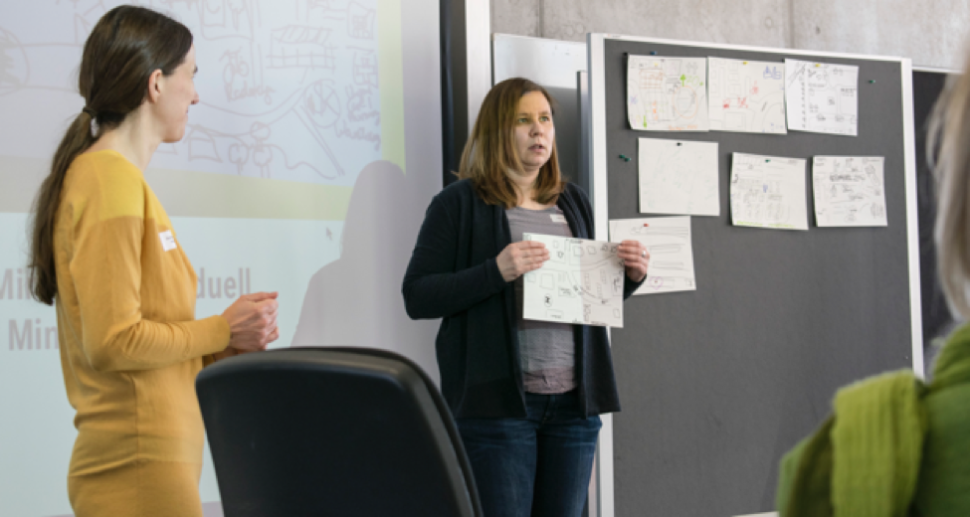
This was an interesting way to get to know one another, and create a sharing, collegial atmosphere. It also produced a list of barriers and enablers to active community life, as well as typical quarters that exemplify the demographics of many German neighborhoods.

These are a few selected results of the exercise:
- Aging Neighborhood: ‘With my little daughter, I live in a town house. There are very few young people and almost no families in our area. Instead, we have an assisted care facility and senior residence and housing geared at retirees. I did not feel like I would fit in at first, but there are many activities for kids at the senior center offers many activities for children, and we like out ‘gray quarter’.
- Downtown Traffic Junction: ‘Though I live very central, and feel like I am close to everything, I don’t do anything in my immediate neighborhood. There is just too much traffic, and noise, and it does not feel safe to walk or bike’.
- Affluent Suburbia: ‘I do not interact with the people in my neighborhood, we all live in our own little boxes. Everyone has a house with garden, every yard is fenced in. And everyone gets home from work to do their own thing. Behind the fence. I am not sure if I would even want to change that or how’.
Big Ideas: Which Topics and Concepts Are Important to You?
Especially when you are facilitating a workshop for subject matter experts outside or adjacent to your own field of technical expertise, it is important to understand the big ideas in the field, as well as the individual participants’ expectations and goals.
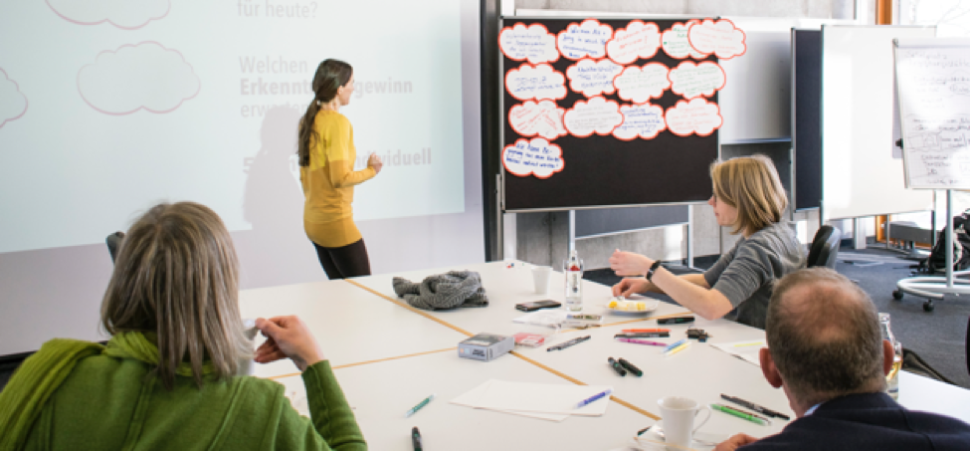
The participants’ goals fell into three groups: (1) Introduction to Design Thinking (2) basic / introductory level exchange on community development (3) pursuing specific ideas or addressing specific problems in community engagement and development, such as ‘dementia, public health (movement, fitness), activating volunteers, offering public participation.
What Level of Community Development Are You Interested In?
Community Engagement can happen in different spaces and places, through events or programs, facilitated by technology and public infrastructure, comprising public, commercial and private spheres.
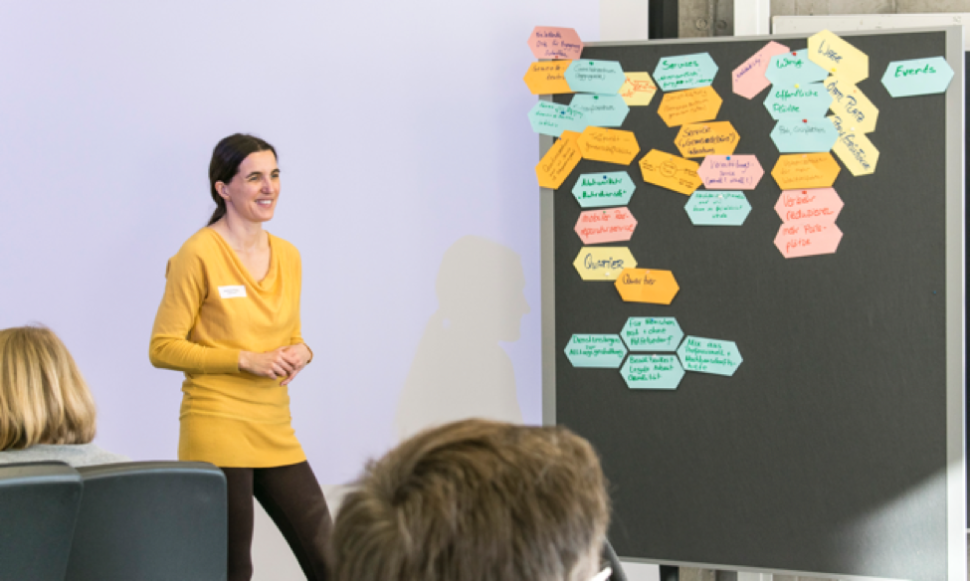
During this exercise, I wanted to see if the group already had a homogenous vision or research agenda, or if the questions and interests were diverse. The latter proofed to be true. However, five general focus areas emerged:
- Community Centers, Community Events
- Parks and Greenways
- Services
- Public Safety
- Mobility
Creating Personas
The use of personas – fictional persons – to represent an abstract consumer originally derived from the field of marketing and, since the late 1990s – inspired by a publication by Cooper (1999) has also been applied within the framework of software engineering to expand other usability methods (Pruitt & Grudin, 2003).
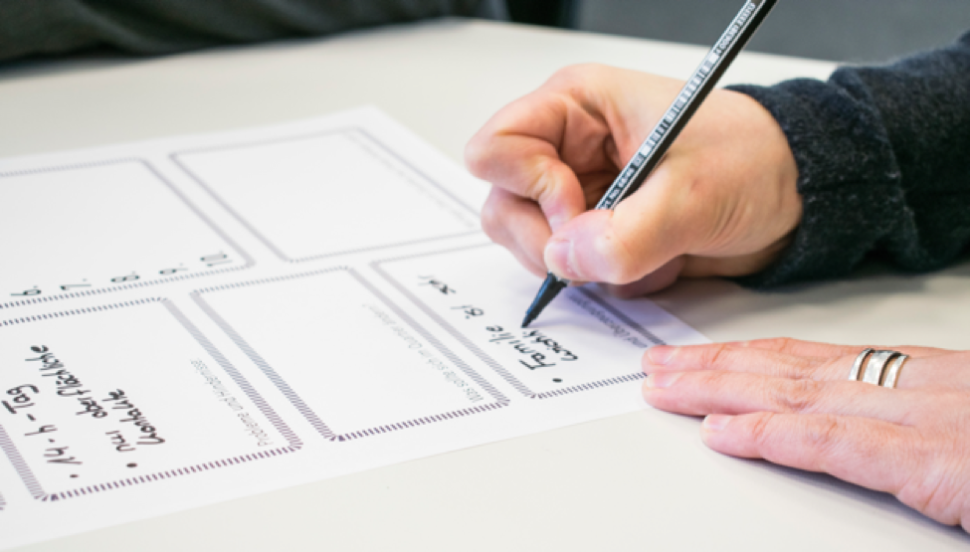
We used the personas approach as a narrative tool to give workshop participants an authentic glimpse into the everyday life of people living in a prototypical neighborhood. Personas are an immersive way for bringing abstract target group information to life through the presence of a specific, fictional personality (Junior & Filgueiras, 2005). Acting as a “projection screen”, personas aid in identifying needs and possible behavioral patterns (Panke, Gaiser & Werner, 2007).
After a brief overview of statistical data on typical demographics in a German neighborhood, participants worked in teams of 3, and designed 1-2 portraits, that outlined characteristics of each persona.

Personas and their legends delivered the necessary context for design decisions and priorities in the next step of the creative process, the design thinking cycle.
If you have more time, it is beneficial to work with the personas and either discard or refine their biographies based on how useful they are for the endeavor at hand, and how credible they are as a storytelling prop. The following exercises can help fleshing out the personas:
- Draw a map for your persona: Where does he, she, them go frequently in the neighborhood?
- Comic Strip: Fold a sheet of paper three times to create eight panels. Now draw a comic strip of your persona in a specific situation that challenges or enables social participation.
- A typical day in the life of…: Create a diary entry for your persona that tells how the persona moves through the day.
Design Thinking Process
During the design thinking process participants cycle rapidly through a series of tasks that prompt them to observe, brainstorm, synthesize, prototype and discuss.
Each participant worked in a dyadic team that went through four design sheets with structured prompts:
- DEFINE & FOCUS: Pick one of the personas and specify which social inclusion problem you want to solve for this person. Remember that how you describe the problem affects the solution, so pay attention to precise, concise and action-oriented language. Present to your partner.
- GENERATE & DEBATE Generate 3-5 ideas to address the problem with novel solutions or disruptive technologies. Aim for a large effect, broad reach and replicable results. Present to your partner.
- SELECT & SKETCH Choose one of your ideas and sketch it out in more detail (literally). Select the best-received, the most interesting to you, the most likely to be implemented, the most unusual or the solution with the most options for collaborating with others. Present to your partner.
- BUILD & PRESENT: Design a prototype or three-dimensional representation of your solution with the materials in the room (card board, paper, tape, clay). Let your partner / the gropup react to the prototype. Both express and receive positive and negative feedback, ideas for improvement or extension, and open questions.
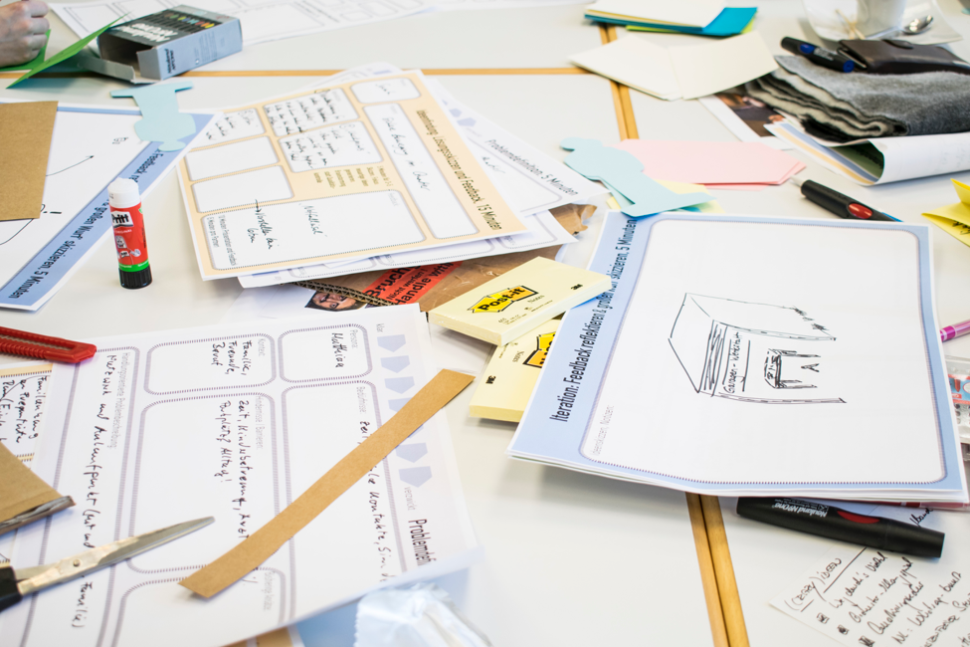
Building out three-dimensional representations of your idea is an important part of the design thinking process. As the blogger Jackie Gerstein puts it ‘the human need to create is innate’ so when people are given the opportunity, materials, and methods, they typically fully embrace making and creating (User Generated Education, March 2018).

We went through two cycles of the design thinking process so that each participant developed, discussed, sketched, and built out two ideas. After the first round, we re-formed the teams, so that everyone worked with two different people, ideally each from a different context.
I recommend two rounds of design thinking, as it allows to work with more than one partner and gain familiarity with the process. Whereas in round one, participants struggled with the time limits, in round two they were often finished ahead of time.
Presenting and Discussing the Results
While the conceptual idea stages where developed in a dyadic setting, each participant presented their prototypes to the whole group and got feedback from the plenum.
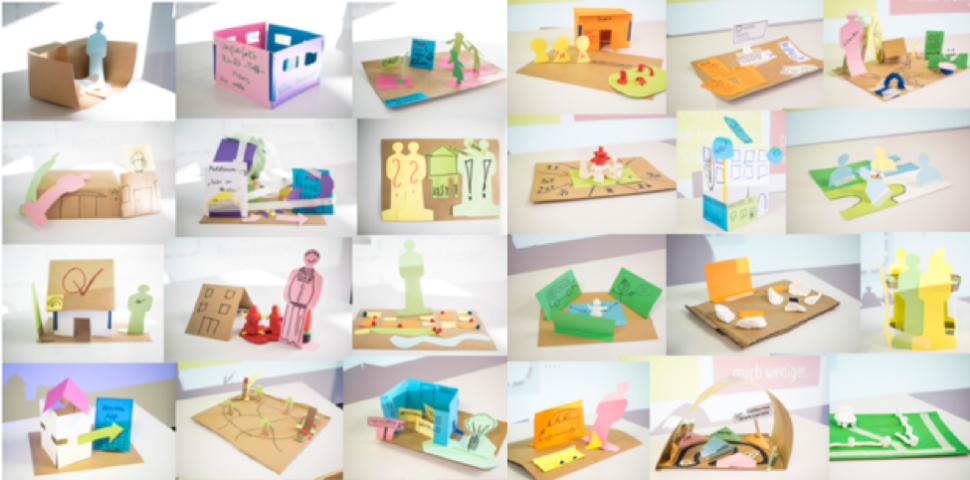
Flip through the slider to see the 28 different design ideas in more detail.
What happens next? Each participant used a traffic light system for a personal summar of the event, using a green, yellow and red card to sort out ideas to pursue, ideas to learn more about or evaluate further, and ideas to discard.
My personal shortlist are the following ideas:
- Intergenerational Car-Sharing: Fewer and fewer young people in Germany purchase their own car. However, for old people, mobility and independence are very much tied to an automobile. An intergenerational car sharing service would allow beginning drivers to use senior residents’ cars in return for assisting with transportation.
- Open Fences: People open up their front yards and create community spaces, for example a bench, that invites neighbors to stop and talk.
- School bus for Seniors: Instead of offering food delivery services (Germany has ‘meals on wheels’ subscription services for senior citizens), the ‘school bus’ picks up senior residents at their home and drives them to a shared lunch location to create community and combat isolation.
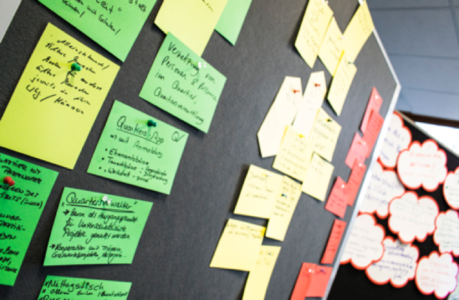
The more activity in the neighborhood, the better the quality of life, the more likely people feel safe while they are out and about and the more they will be able to call upon each other for support. One shared research question emerged in the final discussion that underlies all the ideas developed in the workshop: Why do some community-based initiatives work while others are not accepted and supported by the residents? What is the formula for success to activate a neighborhood? The group meets again to zoom in on this particular research focus.
Summary and Outlook
The central idea of design thinking lies in user-centered product development. By guiding stakeholders through a predefined sequence of exercises the facilitator attempts to foster both empathy and creativity. The playful approach should by no means be misunderstood as ‘anything goes’. Rather, a design thinking process requires careful facilitation with clear rules, especially with regard to time management. Equally important is a thorough follow-up that summarizes and expands upon the results.
Design thinking confronts stakeholders with their preconceived notions of organizational issues or initiatives, and fosters the shared understanding of problem scope as well as crucial components that are difficult to conceptualize. This post provides practical examples that practitioners can re-use, repurpose and adapt.
From a research perspective, my colleague Thilo Harth and I are interested in understanding what makes specific design thinking techniques effective, what are possible limitations and unwanted side-effects, and how design thinking results create transfer learning and outcomes after the event. We will examine the workshop results and survey to participants to answer these questions, and hope to present our results at EdMedia 2018 in Amsterdam.
Project Information
- Kristina Ahlers-Seibel did the photo and video documentation for this workshop, and will summarize results in an infographic / poster.
- For more information on the community development project at Muenster University of Applied Sciences (Germany) see the project website or contact the project team.
References
Brown, T. (2009). Change by Design: How Design Thinking Transforms Organizations and Inspires Innovation. New York: HarperCollins Publishers.
Brown, T., & Wyatt, J. (2010). Design thinking for social innovation. Development Outreach, 12(1), 29-43.
Buchanan, R. (1992). Wicked problems in design thinking. Design issues, 8(2), 5-21.
Cooper, A. (1999). The inmates are running the asylum:[Why high-tech products drive us crazy and how to restore the sanity]. Indianapolis: Sams.
Hodgkinson, G. (2013). Teaching Design Thinking. In J. Herrington, A. Couros & V. Irvine (Eds.), Proceedings of EdMedia 2013–World Conference on Educational Media and Technology (pp. 1520-1524). Victoria, Canada: Association for the Advancement of Computing in Education (AACE).
Panke, S., Gaiser, B., & Werner, B. (2007). Evaluation as Impetus for Innovations in E-learning—Applying personas to the design of community functions. MERLOT Journal of Online Learning and Teaching, 3(2), 179-190.
Pruitt, J., & Grudin, J. (2003, June). Personas: practice and theory. In Proceedings of the 2003 conference on Designing for user experiences (pp. 1-15). ACM.
Rittel, H. W., & Webber, M. M. (1973). Dilemmas in a general theory of planning. Policy sciences, 4(2), 155-169.
Sharples, M., de Roock , R., Ferguson, R., Gaved, M., Herodotou, C., Koh, E., Kukulska-Hulme, A., Looi, C-K, McAndrew, P., Rienties, B., Weller, M., Wong, L. H. (2016). Innovating Pedagogy 2016: Open University Innovation Report 5. Milton Keynes: The Open University
Further Resources
A pioneer of design thinking is the Institute of Design at Stanford, also known as the d.school. They offer a free, one-hour introductory design thinking activity: https://dschool.stanford.edu/resources-collections/a-virtual-crash-course-in-design-thinking
The 2016 Innovating Pedagogy Report highlights ‘Design Thinking’ as an educational trend, and offers a concise summary of the concept: https://iet.open.ac.uk/file/innovating_pedagogy_2016.pdf
